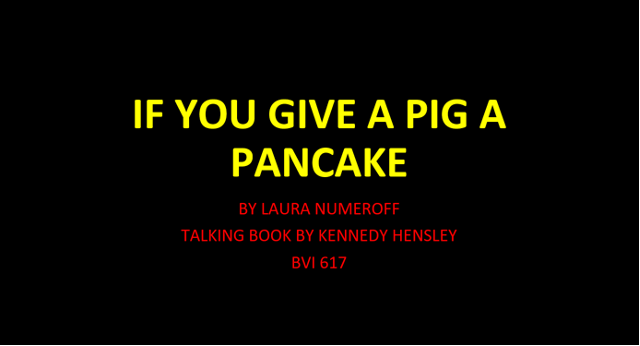Adapting If You Give a Pig a Pancake for Students with Multiple Disabilities
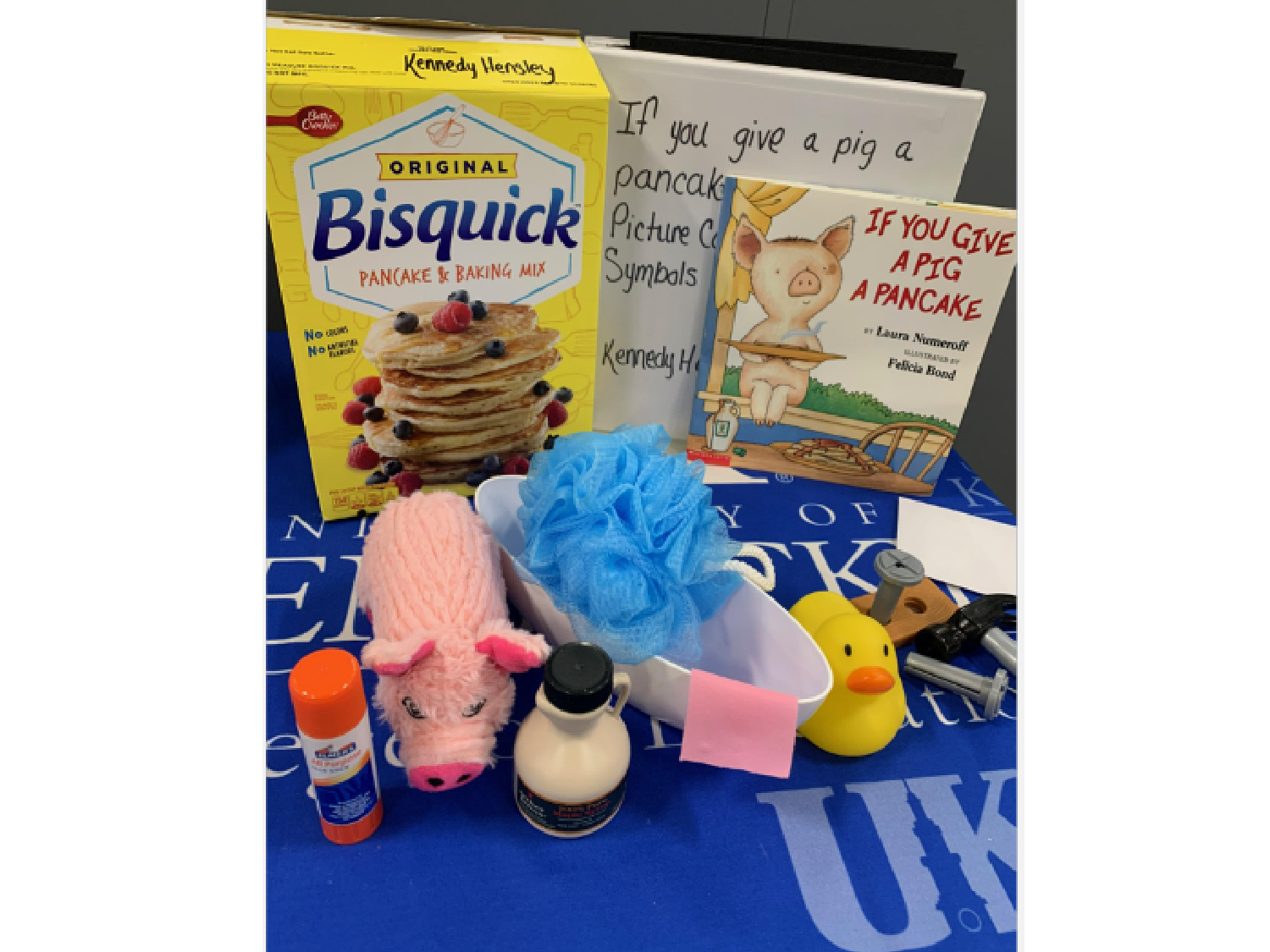
As part of the graduate coursework for Visual Impairments and Multiple Disabilities in the Teacher Preparation Program in Visual Impairments at the University of Kentucky, students were asked to complete four projects: a Story Box with at least 10 objects that correspond to the story, picture communication symbols and tactile communication symbols designed to go along with the story, and a talking book to go along with the story or represent concepts from the story.
We are sharing them on Paths to Literacy and hope that others will use them!
For my project, I chose the book “If You Give a Pig a Pancake” by Laura Numeroff. I had no trouble choosing this book because I love this entire series of books. I think it is so much fun for kids to read about cause and effect, and, even if it is humorous, it is a very good lesson. I had in mind that I could create a story box library out of this specific series, and that was another thought that fueled my desire to use this book specifically.
For students with visual impairments and multiple disabilities, I would definitely recommend the Laura Numeroff books. I feel that the fun inside the book is not limited to children with perfect eye sight or perfect motor skills. I believe the objects are very friendly to our friends with visual impairments, as well as multiple disabilities. I have already tested it out on one of my students who has CVI, and they loved it! The picture communication symbols I chose to go along with my story box were very CVI-friendly, and the objects in the box made my student very happy as well! He thought it was awesome to have cool toys involved in our lesson. Too many times I feel that people brush off students with multiple disabilities and try to “bide their time” by just reading aloud to them and not involving them enough. This allowed him to be involved in the book just the same as any other student.
Story Box:
“If You Give a Pig a Pancake” was made for an amazing story box! I was able to store my objects in a big “Bisquick” box, which is sometimes used to make pancakes. Therefore, there was a big picture of a pancake on the front of the box and even a recipe for how to make pancakes. It was super fun to watch it all come together. I put so much thought into each item and the best storage, that also made it fun for the student when they saw me bring it into class.
Materials I used in my story box included: plastic hammer, plastic nails, plastic wood, an envelope, a small bathtub with a small towel, a loofa, a rubber duck, maple syrup, glue, and of course a pig. The plastic tools and wood could have been better considering I do not want my student to believe that is truly how nails, hammers, and wood feels. However, I thought it would be an awesome experience for the students to be able to use their motor skills to actually hammer the nails into the wood. I will include real items to reinforce that the plastic is not how the items actually feel. I was very pleased with the rest of the items in my box. The tools and wood (3 items) were used because in our book the pig builds a treehouse using nails, a hammer, and wood. The pig was obviously used to represent our lead character. The maple syrup was used so they could feel and maybe even taste the maple syrup mentioned in the book. The glue was so they could feel the sticky or maybe use it as the pig did when he got all sticky while decorating. The loofa, bathtub, and towel were all used to represent how the pig got clean after getting sticky from his favorite maple syrup. The letter was to represent the pictures the pig mailed to all his friends. I plan to continue adding to the box as I go!
This story box will be used to not only make our one-on-one lessons much more fun, but also to make our sessions more inclusive. I have a preschool student and I plan to go to her classroom and read the book with the story box items as a class. That way my student will not feel alone, and it will be fun for the other kids as well! This also may be a great break for the regular classroom teacher. I also believe it will be used to get my students with multiple disabilities more involved. As I said before I never want our reading to feel as though I am brushing them off, and do not expect them to take anything away from the lesson. It is my hope this will make reading more exciting for them, and get them involved in our sessions.
Picture Communication Symbols:
For “Picture Communication Symbols” I chose a variety of pictures that coincide with the book, I could have never narrowed it down to 10 pictures. I ended up having a total of 22 picture communication symbols that I created using board maker online. A list of the pictures includes: pig, pancake, sign language for “sticky,” syrup, bath, bubbles, rubber duck, farm, homesick, closet, suitcase, bed, piano, dance, camera, friends, envelope, mailbox, treehouse, hammer, glue, and nails. I chose to store them on foam board inside of a binder with the title of the book on the front of the binder. I used Velcro to attach each laminated picture to its corresponding spot on the foam board. This made for easy storage, as well as an easy method of choice making for my students.
Comprehension questions I would ask using these picture communication symbols could be geared towards choice making or even sequencing. I could attach 2-4 pictures on one page and ask “Which of these pictures is an animal?” (Pig) “Which of these represent how you get clean?” (Bathtub) “Which of these are used to build things?” )Hammer or nails or both) All kinds of comprehension questions could come out of this. We could also assess listening skills by detaching all pictures and having the student put them on the board in sequence corresponding to the story.
Tactile Symbols:
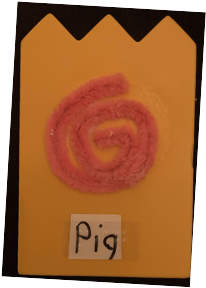
My first symbol is a pig. The pig is on a yellow card because it falls into the category of “people.” This is because the pig in our book, “If You Give a Pig a Pancake,” has human–like characteristics. I used a pink pipe cleaner to represent the pig because they have curly pink tails.
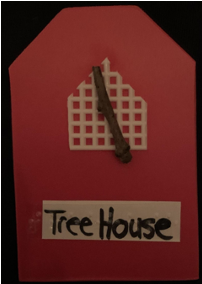
My next symbol represents the treehouse that the pig builds in the book. This symbol will be placed on a red card because it falls under the “places” category. I cut out a house shape in the netted material to represent “house,” then glued a piece of wood on top to represent “tree.”
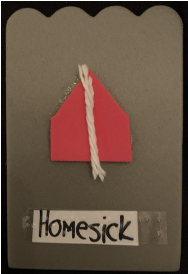
The feeling “homesick” is my next symbol. Because it is a feeling it falls under the category “expansions,” which goes on a gray card. I read on a post by Texas School for the Blind that their symbol for the feeling “sick” is a foam heart with a white string on the top. I wanted to recreate this, but obviously add different meaning. With that being said, I cut out foam in the shape of a house, then laid the white string on the top.
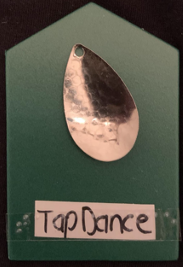
The next two symbols are on a green card because they fall under the “actions” category. This symbol is a small piece of metal to represent the taps on the bottom of tap shoes. This will be used to represent tap dancing.
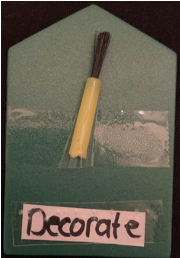
This symbol is used to represent the action “decorate,” as the pig decorates his treehouse he builds. I bought paintbrushes, and cut the tip off and glued it to a green action card. I ended up having to tape the bottom because there was a bit of a sharp edge from the plastic.
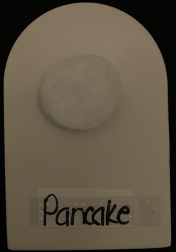
The remaining symbols will be on a white card because they are in the object category. This symbol is used to represent a pancake. I wanted to have a flat object with a soft texture and light color to represent this. I ended up using a crafting pom to create this. I was very happy with the way it ended up. However, I wish I would have been able to provide a little more contrast. Perhaps for a child with CVI I could use a yellow colored pom in place of the white. For a child with no sight, I feel that the texture was great.
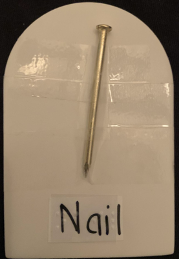
This symbol is a nail. In the book, the pig uses a nail to build his treehouse. This is just a basic small nail used to hang pictures. I taped over the sharp edge, but left the top out so that the child could feel the texture of an actual nail.
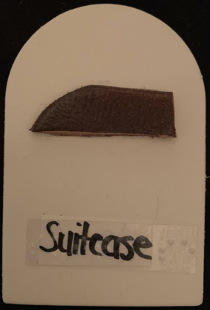
This symbol is used to represent the suitcase mentioned in the book. I cut a small piece off of a leather belt. This will represent the strap on the suitcase.
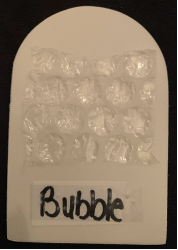
This symbol is used to represent bubbles. This is actual bubble wrap. I have a love/hate relationship with this card because obviously it is low contrast again. However, the texture is perfect for students to recognize the point we are trying to get across here. Every kid loves bubble wrap.
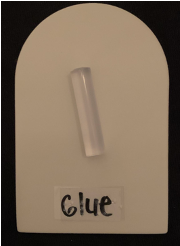
This symbol, again, lacks the contrast that is necessary for students with low vision. It is glue, so I just used a part of a stick of glue that goes inside a hot glue gun. I feel that this conveys the object best my idea.
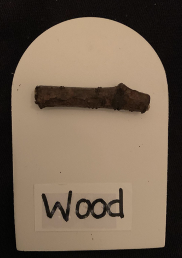
This is the last symbol for the project, although I intend to add more. This symbol represents wood. This is actual wood that I got off of a tree in my yard. I thought about using a popsicle stick, but what better way to convey wood than raw tree wood? I think it will get the point across much better than wood sold in stores.
I labeled each of the tactile symbols with print, as well as braille labels. These are obviously symbols that will need to be built up to, and some are pretty specific to the book. However, I tried to pick some abstract symbols, so that we could use them when we begin to build a base knowledge of tactile symbols.
My way of storage is velcroing each symbol into a binder on foam board, as I did for my picture communication symbols. This way we can practice choice-making, and also easy storage with the picture symbols. I toyed with different ways of storage, but this was the most efficient with saving space and traveling.
Talking Book:
I created this talking book for the children's book "If You Give a Pig a Pancake" by Laura Numeroff. My use of large, loose print, CVI-friendly colors, noncomplex pictures will allow students with multiple disabilities to have a clear understanding of the illustrations in the book. I also recorded my voice reading the book so that my students can read the book more independently, even if I am not present. This will give students a further sense of involvement in the story.

